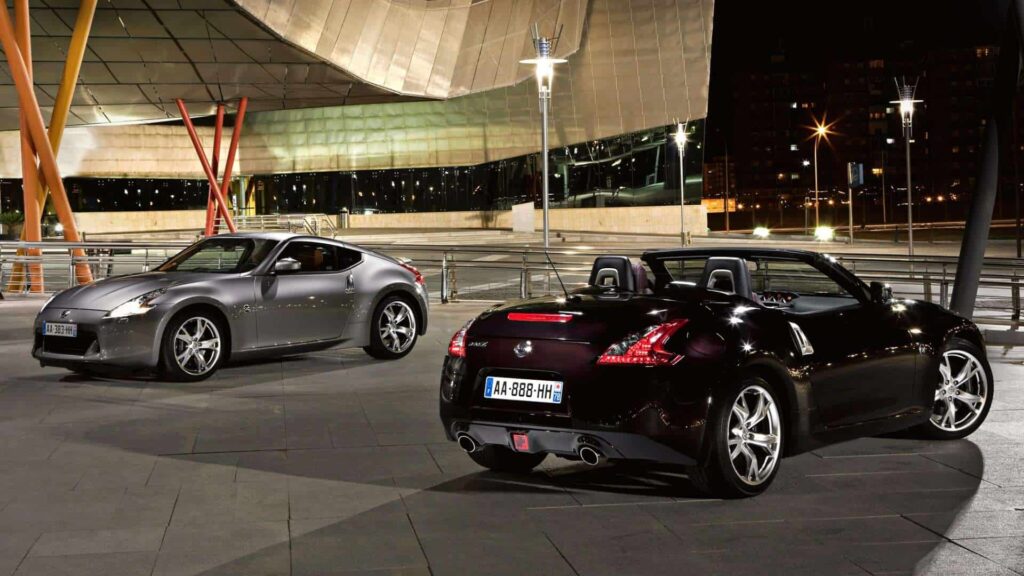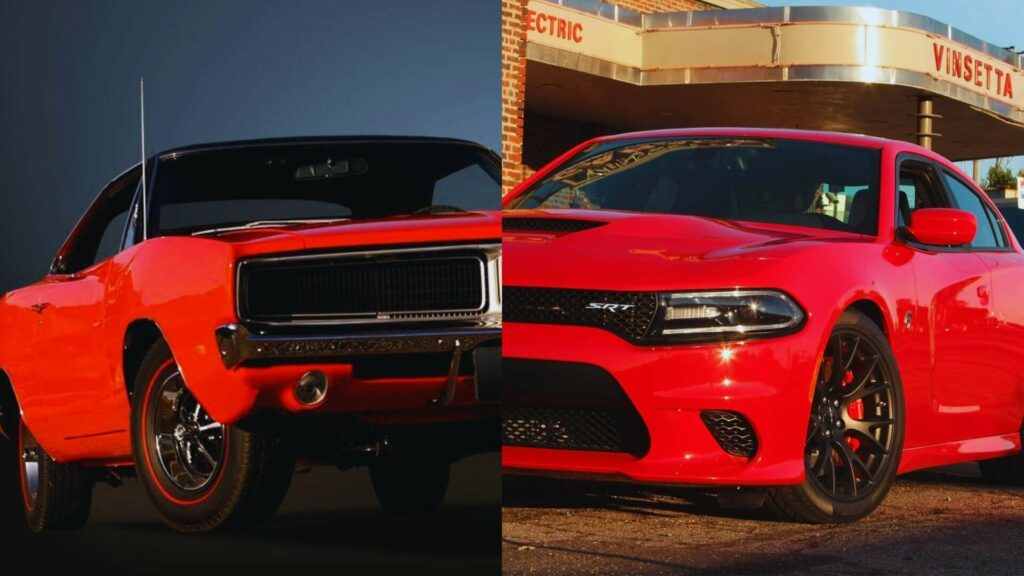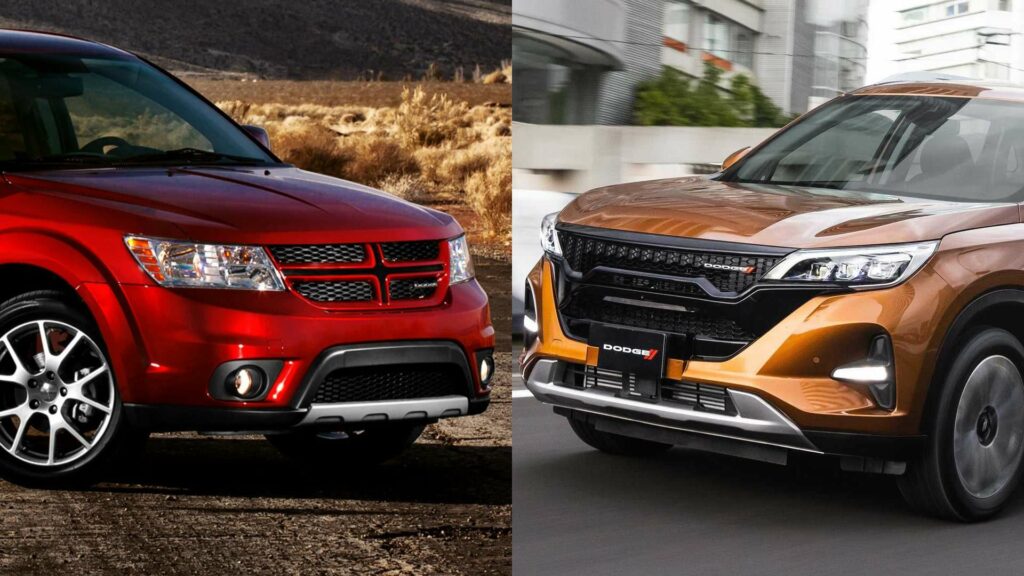We’ve discussed the Nissan 350Z’s weight in a previous article, and now it’s time to do the same for its successor, the Nissan 370Z.
As the newer Z model, the Nissan 370Z was first introduced in 2009 and was produced until the 2020 model year.
Read on as we go over the Nissan 370Z’s weight as well as other important factors that contribute to its overall weight, one model year at a time.
But first, let’s have some ballpark weight figures for both the coupe and the roadster version of the Nissan 370Z below.
How much does a 370Z weigh?
The Nissan 370Z coupe has a curb weight of 3232 lbs (1466 kg) to 3493 lbs (1584 kg) depending on the year, trim, and in some cases, the transmission.
The Nissan 370Z roadster has a curb weight of 3332 lbs (1511 kg) to 3525 lbs (1599kg) depending on the year, trim, and in some cases, the transmission.
Just like with the 350Z, the coupe version of the Nissan 370Z is lighter on average compared to its roadster (or convertible) counterpart.
This is generally the case for the convertible version of a lot of cars. Since they lack a “hardtop” roof, extra materials are fitted into their frames to compensate for their reduced rigidity.
As a result, convertible models like the Nissan 370Z roadster weigh heavier than their corresponding hardtop versions.
However, there are several other factors to consider that affect the total weight of a specific vehicle model.
Other than its body style, the Nissan 370Z’s overall weight is also dependent on the specific model year, trim level, and even the type of transmission.
Nissan 370Z Weight By Model Year
For this part, we have listed all of the possible curb weights of the Nissan 370Z according to model year.
Within one model year, you will see how the combinations of trim levels, body styles, and transmissions all equate to a different curb weight.
Do keep in mind that not every model year below has a “transmission” column, as both the manual and automatic transmission models have exactly the same curb weight, in that case.
2009 Nissan 370Z Curb Weight
The Nissan 370Z only came in a coupe body style for its first model year in 2009, with the base coupe weighing the lightest at 3,232 lbs.
The Touring coupe was the middle trim as well as the middleweight among the models, weighing in at just an extra 37 lbs more (3,269 lbs) than the base trim.
Unlike the 350Z, the Nissan 370Z already had a Nismo Edition within the first model year, and it weighed the heaviest at 3,300 lbs.
Overall, the 370Z’s first model year had one of the lightest models partly because of the absence of roadster models.
2010 Nissan 370Z Curb Weight
For the 2010 model year, roadster body styles were added for the base and Touring trims, which had curb weights of 3,426 lbs and 3,467 lbs respectively.
While this meant that the Touring roadster trim was the heaviest 370Z model for 2010, the lightest model was still the base coupe with no changes to its curb weight.
2010 was also the first model year that the “40th Anniversary Edition” 370Z was offered, and it had exactly the same curb weight as the Touring coupe (3,269 lbs).
2011 Nissan 370Z Curb Weight
The Nissan 370Z’s curb weight remains largely unchanged for the 2011 model year, except for the Touring coupe that actually gained 9 lbs more on top of its previous curb weight.
The lightest 2011 370Z model was still the base coupe at 3,232 lbs, while the Touring roadster still weighed the heaviest at 3,467 lbs.
The 40th Anniversary Edition model was no longer offered in 2011, leaving the 3,300-lb Nismo Edition as the sole “high-level” trim.
2012 Nissan 370Z Curb Weight
The Nissan 370Z base trim saw a slight increase in its curb weight for the first time in 2012, going from 3,232 lbs to 3,245 lbs, yet it still remained the lightest.
This is also true for the rest of the trims, with the base roadster gaining the most weight at 33 lbs more than its previous model year curb weight.
However, the 3,467-lb Touring roadster was still the heaviest trim for the 2012 model year.
2013 Nissan 370Z Curb Weight
With even more features added to the 370Z in 2013, so do the curb weights of all the trims continue to go up slightly.
Despite the increase in weight across all trims, the lightest and heaviest trims did not change at all from last time.
The lightest and heaviest trims were the 3,272-lb base coupe and the 3,488-lb Touring roadster, respectively.
2014 Nissan 370Z Curb Weight
The curb weights for all the trim levels of the 2014 Nissan 370Z remained exactly the same as the ones for the previous model year.
Thus, the lightest base coupe trim still weighed exactly 3,272 lbs, while the heaviest Touring roadster trim also stayed at 3,488 lbs.
2015 Nissan 370Z Curb Weight
Not only was more weight added to some Nissan 370Z trims for the 2015 model year, but even more trim levels were offered too.
The base coupe still remained the lightest despite jumping up to 3,320 lbs in curb weight.
Similarly, the Touring roadster was still the heaviest, with an increased curb weight of 3,510lbs, which also made it the first-ever Nissan 370Z to hit the 3,500-lb mark.
New trims for 2015 included the 3,488-lb Sport Touring, the 3,327-lb Sport Tech, and the Nismo Tech, which weighed exactly the same as the normal Nismo (3,346 lbs).
2016 Nissan 370Z Curb Weight
For the 2016 model year, there was a mix of trim levels that had their curb weights either reduced or increased from the previous year.
Trim levels with reduced curb weights include the base coupe, base roadster, Touring coupe, Touring roadster, and Sport Touring roadster.
The 2016 Sport Touring roadster, in particular, only had a curb weight of 3,332 lbs, which is about as light as you can get out of any 370Z roadster ever released from the factory.
However, it was still 16 lbs shy of the lightest 2016 trim, the 3,316-lb base coupe.
And as expected, the heaviest trim of the 2016 model year is also the Touring roadster, which weighed 3,501 lbs.
2017 Nissan 370Z Curb Weight
Another round of weight increases was done for the 2017 Nissan 370Z model year, and it affected all trims except for the standard Nismo trim.
This time, the Sport Touring roadster tied the Touring roadster’s 3,521-lb curb weight, making both of them the heaviest 2017 Nissan 370Z trims.
As for the lightest trim, it was still the base coupe with a curb weight that totaled 3,332 lbs, 16 lbs heavier than its curb weight in 2016.
2018 Nissan 370Z Curb Weight
The standard 370Z Nismo trim was not offered for the 2018 model year, leaving the “Nismo Tech” trim as the only Nismo option.
Curb weights further increased slightly for most of the trims, with the only exceptions being the Touring roadster and the Sport Touring roadster.
The 3,333-lb base coupe and the 3519-lb Touring roadster were the lightest and heaviest 370Z trims for the 2018 model year, respectively.
2019 Nissan 370Z Curb Weight
For the 2019 model year, whether the Nissan 370Z was equipped with a manual or automatic transmission started to play a role in its fluctuating curb weight.
Specifically, the manual variant of the base coupe was the lightest among the 2019 trims, weighing in at 3,333 lbs.
Contrary to previous model years, the heaviest 370Z trim for 2019 was actually the 3,525-lb Sport Touring roadster equipped with an automatic transmission.
2020 Nissan 370Z Curb Weight
2020 was the final model year for the Nissan 370Z, which only offered the model in a coupe body style like back in 2009.
With no 370Z roadsters for the 2020 model year, the curb weight range maxed out at only 3,486 lbs with the automatic Nismo trim.
At the other end of the spectrum, the manual base coupe had the lightest curb weight at 3,333 lbs, which was identical to the previous year’s curb weight.
Other Nissan 370Z Specifications
The Nissan 370Z, as its name suggests, is equipped with a 3.7-liter V6 engine called the “VQ37VHR”.
Like the VQ35 from the 350Z, the VQ37 underwent multiple revamps during the 370Z’s production.
This led to horsepower and torque figures that were around 324hp to 350hp and 268 lb-ft to 276 lb-ft, depending on the model year.
As with the 350Z, the Nissan 370Z also comes equipped with an FR (Front-Engine Rear-Wheel Drive) drivetrain, making it a proper contender in motorsports such as drifting.

Choices of transmission for the 370Z include a 6-speed manual and a 7-speed automatic complete with paddle shifters.
The 370Z has a wheelbase of 100.4 inches (2,550mm), which is actually a few inches shorter compared to the 350Z’s 104.3-inch wheelbase.
Basic Nissan 370Z Specifications:
Engine: 3.7L V6 (VQ37VHR)
Power: 324 hp @ 7,000 RPM to 350 hp @ 7,400 RPM
Torque: 268 lb-ft to 276 lb-ft
Drivetrain: Front-Engine Rear-Wheel Drive (FR)
Transmission: 6-Speed Manual or 7-Speed Automatic with Paddle Shifters
Wheelbase: 100.4 inches (2,550 mm)
What are the safety ratings for the Nissan 370Z?
Before buying a Nissan 370Z or any sports car, it’s also important to consider just how safe it is to actually drive.
While it is more modern than the 350Z in terms of safety features, how does that actually translate into actual safety ratings with real-world data?
Unfortunately, both the NHTSA (National Highway Traffic Safety Administration) and the IIHS (Institute for Highway Safety) have neither given safety ratings nor conducted crash tests for the 370Z.
To substitute this, we’ll be looking at the various safety and handling features of the 370Z in order to come up with our own conclusion instead.
Nissan 370Z Safety and Handling Features

The rather long production run of the Nissan 370Z allowed it to be equipped with numerous upgrades over the years, including those related to safety and handling.
Even during its first model year, the 370Z already came with a set of front, side, and overhead airbags for the occupants.
It also has ABS (anti-lock braking system), traction control, and stability control, which are all important for a car with this much performance capability.
Unless you were to turn off all three of the aforementioned handling assist features, you would generally not find it hard to control the 370Z in everyday driving.
Nissan 370Z Safety and Handling Features (2020 Model Year):
- Front Impact Airbags
- Side Impact Airbags
- Overhead Airbags
- Seatbelt Pretensioners
- Anti-Whiplash Head Restraints
- Anti-Theft/Security System
- Anti-Lock Braking System (ABS)
- Traction Control
- Stability Control
On paper, the Nissan 370Z is already a step above the older 350Z in terms of safety and handling features.
While we don’t have actual crash statistics, it’s already a given that tons of 370Zs have been wrecked over the past decade just by looking around the internet.
However, it’s still difficult to come up with a conclusion on how safe it is just based on that alone.
Nonetheless, it’s still important to exercise caution when driving a sports car like the 370Z, regardless of its safety features or ratings.
This is because one big factor that can also play a role in whether a car is safe or not is the ability of the driver itself.
What is the Nissan 370Z’s weight distribution?
From the factory, the Nissan 370Z comes with a weight distribution of 55:45. In other words, 55% of its weight comes from the front half, while 45% of it comes from the rear.
While it does mean that it’s a bit more “front-biased” compared to the 350Z’s 53:47 weight distribution, the 370Z is still able to achieve a 50:50 balance during acceleration.
According to Nissan’s engineers, this 55:45 ratio works ideally for the 370Z, especially when it accelerates out of a turn.
This works wonders for the Nissan 370Z when you take it out to the track, as it allows you to have better contact on all four tires, leading to higher speeds during cornering.
Is the 370Z lighter than the 350Z?
The answer to whether or not the 370Z is lighter than the 350Z actually depends on the exact trim level that you get.
When comparing the curb weights of their lightest trims, the base 370Z (3,232 lbs) is actually 44 lbs heavier than the base 350Z (3,188 lbs).
When it comes to the heaviest trims, however, the automatic 370Z Sport Touring roadster (3,525 lbs) is actually lighter than the automatic 350Z Grand Touring roadster (3,616 lbs) by 91 lbs.




